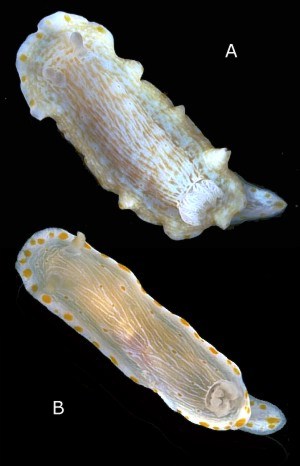
Chromodoris epicuria
(Basedow & Hedley, 1905)
Order: NUDIBRANCHIA
Suborder: DORIDINA
Superfamily: EUDORIDOIDEA
Family: Chromodorididae
PHOTO
UPPER RIGHT: A, Mallacoota, northern Victoria, 14mm long alive, February 1983. B, Bicheno, eastern Tasmania, 31mm long alive, May 1985. LOWER LEFT: Ulverstone, northern Tasmania, 35mm long alive, February 1984. On food sponge Darwinella gardneri. LOWER RIGHT: Eyre Peninsula, South Australia, 23mm long alive, February 1985. On food sponge Darwinella cf. gardneri. PHOTOS: Bill Rudman.
There is some variation in colour in this species throughout its range, different parts of the colour pattern being emphasised in different populations. In general the body and mantle are translucent whitish with the creamy-brown or pinkish viscera showing through. Around the edge of the mantle is a broad band of opaque white resulting from both surface pigmentation and the opaque white subepithelial mantle glands. The mantle is marked with thin irregular white lines arranged longitudinally. There are also large orange spots which form a submarginal band around the mantle and smaller orange spots scattered all over the central part of the mantle. Each of these small orange spots sits on a white line and is surrounded by a thin white ring. The orange ranges from a pale yellow-orange to a dark red-orange in different specimens. The gills and rhinophores are translucent and both are edged in white. The foot and the sides of the body are translucent with a dusting of white. There is a submarginal band of orange spots around the foot, including the anterior edge.
Regional variation:
•Victoria: Specimens from Mallacoota in northeastern Victoria are heavily pigmented with creamy-white closely spaced lines forming a prominent pattern on the dorsum. The background colour is a translucent yellow-brown. Orange spots form a submarginal band around the mantle edge but there are few orange spots elsewhere on the mantle. In contrast specimens from Western Port and Port Phillip Bay in southern Victoria have a translucent mantle finely dusted with white and with traces of longitudinal white lines. There are orange spots scattered over the central part of the mantle. •Tasmania: Specimens from both the northern and southern coasts are similar to the southern Victorian specimens.
• South Australia: Specimens from both the Eyre and Yorke Peninsulas were examined. In both samples the longitudinal white lines though often present were not prominent. The orange spots in the central part of the mantle are each surrounded by a prominent white ring and the spot is usually slightly raised. The background of the mantle has either very little white dusting and so is translucent except for the opaque viscera and white band of mantle glands, or was heavily dusted in red giving the body a deep pinkish background. Most specimens with a deep pinkish background have only irregular traces of the longitudinal white lines. One consequence of the pinkish background is that the orange spots on the inner part of the mantle appear much darker (almost red) than those forming the submarginal mantle band where the background is white. In these pinker specimens there is often orange spots or lines on the edge of the gills.
This species was described from South Australia eighty years ago (Basedow & Hedley, 1905) but as the original description was based on one specimen of an unusual colour form it has remained unrecognised in the literature since that time. Burn (1957), named the common Victorian colour form, with distinctive longitudinally arranged white lines, Glossodoris victoriae, not recognising its relationship to Basedow & Hedley's Hypselodoris epicuria. Specimens from Tasmania are very similar in colour to those from southern Victoria and some specimens from both the Eyre and Yorke Peninsulas of South Australia have the typical colour pattern of "Glossodoris victoriae". Many of the specimens from Eyre Peninsula however show partial or complete loss of the longitudinal white lines and sometimes the development of red dusting over the dorsum, giving the body a reddish pink appearance. Specimens with a heavy red dusting and complete loss of the white lines fit the original illustration of Hypselodoris epicuria very well. See page on red-spotted species from south eastern Australia. Compare with C. tasmaniensis and C. splendida.
References:
•Rudman, W.B. (1983 ) The Chromodorididae (Opisthobranchia: Mollusca) of the Indo-West Pacific: Chromodoris splendida, C. aspersa and Hypselodoris placida colour groups. Zoological Journal of the Linnean Society, 78: 105-173.
•Rudman, W.B. (1987a) The Chromodorididae (Opisthobranchia: Mollusca) of the Indo-West Pacific: Chromodoris epicuria, C. aureopurpurea, C. annulata, C. coi and Risbecia tryoni colour groups. Zoological Journal of the Linnean Society, 90: 305-407.
•Rudman, W.B. (1991) Purpose in Pattern: the evolution of colour in chromodorid nudibranchs. Journal of Molluscan Studies, 57, (T.E. Thompson Memorial Issue): 5-21.
PHOTOS:
UPPER RIGHT: A, Mallacoota, northern Victoria, 14mm long alive, February 1983. B, Bicheno, eastern Tasmania, 31mm long alive, May 1985. LOWER LEFT: Ulverstone, northern Tasmania, 35mm long alive, February 1984. On food sponge Darwinella gardneri. LOWER RIGHT: Eyre Peninsula, South Australia, 23mm long alive, February 1985. On food sponge Darwinella cf. gardneri. PHOTOS: Bill Rudman.

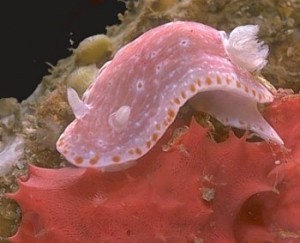
Rudman, W.B., 1999 (October 11) Chromodoris epicuria (Basedow & Hedley, 1905). [In] Sea Slug Forum. Australian Museum, Sydney. Available from http://www.seaslugforum.net/find/chroepic
Related messages
Re: Chromodoris multimaculosa from Bicheno, Tasmania
May 31, 2010
From: Capt John Silberberg
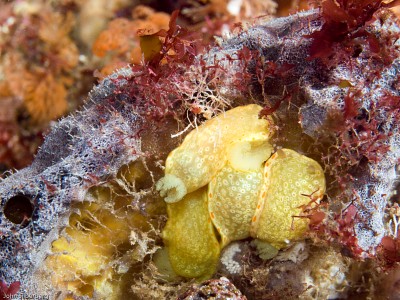
Concerning message #23688:
Hi Bill
They were still there on 28 May 2010.
There was a heavy surge and while I was watching, one was washed out. I caught it, photographed it and returned it to the reef.
Locality: The Rock, Waubs Bay, Bicheno, 12 metres, Tasmania, Australia, Tasman Sea, 28 May 2010, Rocky Reef. Length: 15 mm. Photographer: Capt John Silberberg.
Also, better pics attached, including what appears to be an egg mass.
Cheers
John.
john.silberberg@bigpond.com

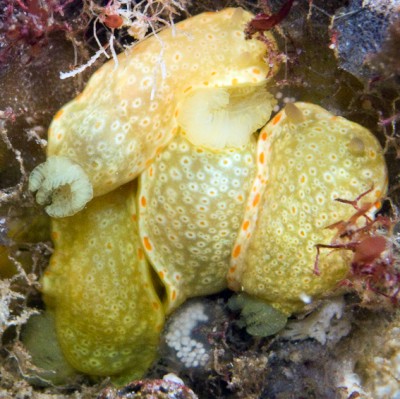
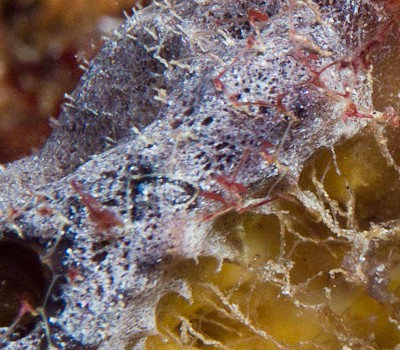
Dear John,
Thanks very much for these much clearer photos. As Greg Close says in his accompanying message [#23694] I was wrong in identifying your animal as C. multimaculosa, they are a spotted form of C. epicuria. In these photos the mantle is clearly translucent with white surface pigmentation.
The egg mass is interesting because the large eggs suggest the owner of them has direct development which means that the eggs hatch out as small crawling slugs rather then as small free-swimming veliger larvae. I can't find any record of its eggs so it would be interesting to know if anyoine else has found similar egg masses associated with C. epicuria.
The other interesting bit of information I can get from your photos is that they are clearly eating a large sponge colony and from the stringy network of fibres we can see it most probably a darwinellid sponge. Certainly the purplish outer layer of the colony is almost certainly Chelonaplysilla violacea but I am not sure whether the inner yellow region is a separate sponge or the inner pasrt of the Chelonaplysilla colony. Whatever it is, the nudibranchs have burrowed deeply into it. Large clusters of feeding animals like this support the idea that this is a direct developing species. For example, the southeastern Australian species, C. tasmaniensis, is a direct developer and is often found in groups like this on its favoured sponge Darwinella gardineri. I have reported C. epicuria feeding on D. gardineri, so your photos showing it in Chelonaplysilla violacea is a valuable addition to our knowledge.
Best wishes,
Bill Rudman
Re: Chromodoris multimaculosa from Bicheno, Tasmania
May 31, 2010
From: Greg Close
Concerning message #23688:
Hi Bill,
Greg Close from Devonport here.
With reference to John's photo. The smaller beasts in the right of the shot are almost certainly Chromodoris epicuria. Given that they are in the grouping with the many spotted guys, I figured that it is likely that they are the same species with a variation in colour. A photo in Karen Gowlett-Holmes book, 'A field guide to the Marine Invertebrates of South Australia' indicates this also. (pge. 159)
Anyway, I'm still dabbling and hope this finds you well.
Cheers
Greg.
exclosei@bigpond.com
Close, G., 2010 (May 31) Re: Chromodoris multimaculosa from Bicheno, Tasmania. [Message in] Sea Slug Forum. Australian Museum, Sydney. Available from http://www.seaslugforum.net/find/23694Dear Greg,
What a pleasant surprise to know you are still taking a interest in nudibranchs. John has sent me some much clearer photos of the animals [message #23695], and as you say, they are indeed C. epicuria. All I can say is that the colour was misleading in the original photos - but still a bit embarassing considering I was the one that supposedly 'sorted out' these colour groups in southeastern Australia.
To those of you who aren't familiar with the name 'Greg Close', Greg is the one I named Noumea closei after, for his invaluable help during an exhaustive collecting trip to Tasmania in 1984 and in sending further material to me in Sydney
Best wishes,
Bill Rudman
Chromodoris multimaculosa from Bicheno, Tasmania
May 29, 2010
From: Capt John Silberberg

Hi Bill
Please help me ID the nudis in the attached pic.
Candidates: Chromodoris epicurea, Noumea haliclona and Noumea closei
Found on "The Rock" in Waubs Bay at Bicheno on Tasmania's east coast.
Locality: The Rock, Waubs Bay, Bicheno, 12 metres, Tasmania, Australia, Tasman Sea, 8 May 2010, Rocky Reef. Length: Approx 20 mm. Photographer: Capt John Silberberg.
Cheers
John.
john.silberberg@bigpond.com
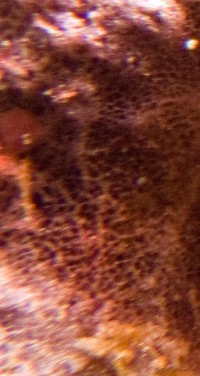

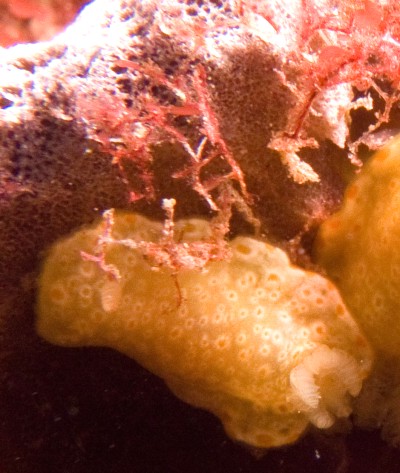
Note added 31 May 2010: This is Chromodoris epicuria. See message #23694.
Dear John,
Tasmania has a multitude of chromodorid species with orange and red spots so you are correct to be cautious. It certainly looks like it could be one of the yellow species from that region [see Noumea flava colour group] and the orange spots with white around them look quite like N. closei.
However I am pretty sure this is another species, Chromodoris multimaculosa, which until now I haven't added to the Forum. If your cluster of 5? animals is this species, then you have almost doubled the number of known specimens and given us an indication of the sponge it feeds on.
Best wishes,
Bill Rudman
Can you please id this nudi?
October 26, 2006
From: Trevor McMurrich
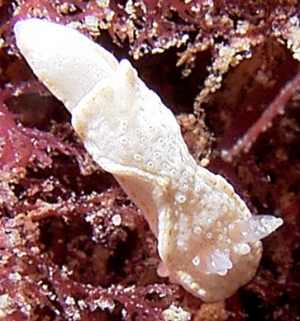
Hi Bill,
I was wondering if you could Identify this nudibranch for me. I found it on the inside wall of Popes Eye in Port Phillip Bay. I'm sorry for the over-exposure.
Locality: Popes Eye, Port Phillip Bay, 1 metre, Victoria, Australia. 12 August 2006, rocky reef. Length: 15 mm. Photographer: Trevor McMurrich.
Thank you
Trevor
trevm@aanet.com.au
McMurrich, T.B., 2006 (Oct 26) Can you please id this nudi?. [Message in] Sea Slug Forum. Australian Museum, Sydney. Available from http://www.seaslugforum.net/find/17477Dear Trevor,
I am pretty sure this is a colour form of Chromodoris epicuria. The inward folding of the mantle on each side is reminiscent of a species of Noumea, but the only one with a similar colour pattern, Noumea closei, doesn't normallly have such folding and at 15mm length would have a bright yellow background colour.
Best wishes,
Bill Rudman
Chromodorid from S.E. Australia
June 26, 2002
From: John Chuk
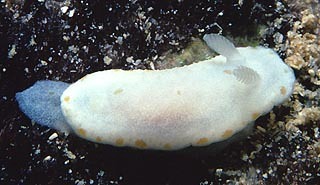
Dear Bill,
Here is an image of a nudibranch I'm having difficulty identifying. The specimen was photographed in Port Campbell Harbour, Victoria, Australia on the 1st of May 2001. It was found at a depth of 4.5m and measured 10mm in length.
The mantle is somewhat translucent, has a covering of fine white spots, a row of orange spots along the margin, and several orange spots in the central portion. The foot is rounded, extends well beyond the mantle when in motion, and is translucent with fine white spots and a single larger orange spot. The rhinophores are lamellate. Both rhinophores and gills are translucent white in colour.
Is it a juvenile specimen of Chromodoris tasmaniensis? Or a juvenile Chromodoris epicuria? Or could it be Noumea aureopunctata? It appears to have features of all three! Any help with the identity would be greatly appreciated.
Best wishes,
John.
jchuk@giant.net.au
Chuk, J., 2002 (Jun 26) Chromodorid from S.E. Australia. [Message in] Sea Slug Forum. Australian Museum, Sydney. Available from http://www.seaslugforum.net/find/7297Dear John,
Your message has forced me to prepare a page on Noumea aureopunctata. I don't know how it missed out before, but at least its here now. If you have a look at that you will see that I consider it can sometimes be nearly impossible to sort out juveniles of the three species you mention from each other externally. N. aureopunctata always has golden yellow spots while the others have spots ranging from yellow to orange. The spots around the mantle edge of N. aureopunctata are usually not round, and usually it is the only one in which the spots actually touch the edge.
The spots in your photo are rounded, orange, and not touching the edge so I don't think it is N. aureopunctata. Of the other two, the faint spots in the middle of the back suggest it may be Chromodoris epicuria, but that is only a considered guess.
best wishes,
Bill Rudman
Chromodoris epicuria from South Australia
March 8, 2002
From: Stuart Hutchison
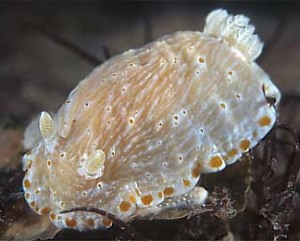
Bill,
Here's a Chromodoris epicuria from the wreck of The South Australian off Adelaide, South Australia on 26 Sep 1999. Depth 20m, length 40mm.
A pretty obscure looking species and not so common from my experience.
Regards,
Stuart
stuart@stuarthutchison.com.au
Hutchison, S., 2002 (Mar 8) Chromodoris epicuria from South Australia. [Message in] Sea Slug Forum. Australian Museum, Sydney. Available from http://www.seaslugforum.net/find/6286Thanks Stuart,
It's interesting to see one with lines. In South Australia the lines are often very obscure or absent while in the eastern part of its range (NE Victoria) the lines predominate and sometimes the spots are absent.
Best wishes,
Bill Rudman
Chromodorid from South Australia
August 21, 2001
From: John Chuk


Dear Bill,
I'm sending in situ images of another chromodorid that I am unable to identify. They are of two specimens photographed on 19 February 2001 at Rapid Bay Jetty, South Australia. Both were found beneath the end of the jetty at a depth of 9m.
Both specimens are very similar, only differing in size and the number of spots on the mantle. The pattern and coloration is somewhat diffuse giving the specimens an out of focus appearance. The mantle is somewhat translucent with a pinkish tinge and has small red spots on it that have pale areolae. Opaque white mantle glands form a band to the mantle. There is also a submarginal band of scattered orange-red spots. The gills and rhinophores are translucent. The gills are tinged pink on their inner edges.
The first image is of a specimen, 7 mm in length, found wandering over filamentous algae. The second image is of a specimen, 5mm in length, found on what appears to be a red Darwinella sp. sponge. On a later dive I found two more specimens of the same species on a similar sponge suggesting that it may be the food source.
When I found them on the dive I thought they could be a variation of Noumea haliclona but inspection of the slides made me doubt that identification. What do you think?
Thanks again for all your help!
Best Wishes,
John.
jchuk@giant.net.au
Chuk, J., 2001 (Aug 21) Chromodorid from South Australia. [Message in] Sea Slug Forum. Australian Museum, Sydney. Available from http://www.seaslugforum.net/find/5009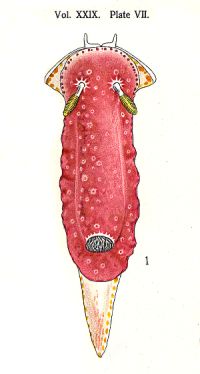
Dear John,
South-eastern Australia is the home of these red-spotted chromodorids and some species have different colour patterns in different parts of their geographic range. I am pretty sure your photos are of Chromodoris epicuria which changes from a species in which lines dominate the colour pattern in Victoria across to South Australia where the background can become quite pink, the lines disappear and spots predominate.
I have included alongside Basedow's painting [Pl.7, fig 1] which illustrated Basedow & Hedley's original description of this species. There are two species, C. multimaculosa and Noumea spencerensis which I need to add to complete the picture concerning these southern red-spotted species.
Best wishes,
Bill Rudman
